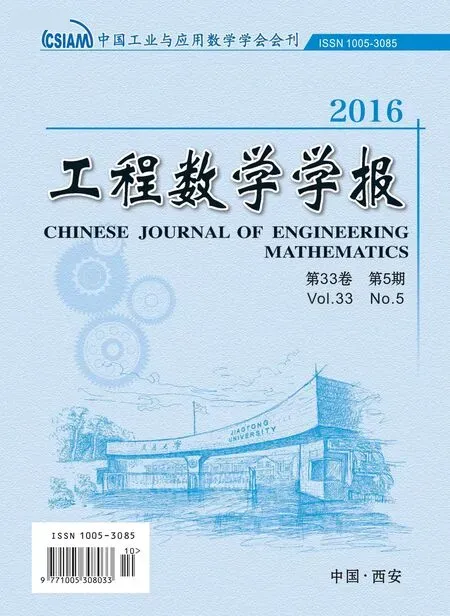General Coulson-type Integral Formula for theEnergy of Digraphs?
GAO Nan,LV Wei
(1-Department of App lied Mathematics,Northwestern Polytechnical University,Xi’an 710072;2-College of Science,Xi’an Shiyou University,X i’an 710065)
1 Introduction
D=(V,H)denotes a digraph of order n,where V={v1,v2,···,vn}is the set of vertices of D with|V|=n,and H is the set of arcs consisting of ordered pairs of distinct vertices.Throughout this paper,we assume that D has no loops and no multiple arcs.
The ad jacency matrix A of a digraph D whose vertex set v1,v2,···,vnis n × n matrix,and the entry aijis defined as

The characteristic polynom ial|x I?A|of thead jacencymatrix A of D is called the characteristic polynom ialof D and it isdenoted by ?A(D,x).Theeigenvaluesλ1,λ2,···,λnof A are called eigenvalues of D.The eigenvalues of D are in general com plex numbers as the ad jacency matrix A of D is not necessarily a symmetric matrix.
The energy of digraphswas introduced by Pe?na and Rada in[1].It was defined as

where λ1,λ2,···,λnare the(possibly com plex)eigenvalues of D and Re(λi)denotes the real part ofλi.
The energy E(G)of G is defined to be the sum of the absolute values of the eigenvalues of G,which is an invariant related to totalπ-electron energy[2].In 1940,Coulson[3]obtained an im portant integral formula whichmakes it possible to calculate the energy of a graph w ithout know ing its spectrum.That is,for a graph G,its energy

where?A(G,x)is the characteristic polynom ial of A(G)(called the characteristic polynom ial of G).
In the case of a digraph D with n vertices,it was shown[1]

In thispaper,wegivea generalCou lson-type integral formula for theenergy ofdigraphs.This formula is app lied to any polynom ialswhose sum s of the eigenvalues are zeros.
2 prelim inaries
We firstly introduce some basic concepts and results from com plex analysis which w ill be used later.The following three results in com plex analysis arewell known(see[4]).
Lemm a 1(Cauchy’s theorem)Let D bea bounded domainw ith piecew isesmooth boundary.If f(z)is analytic on D,and extends smoothly to?D,then∫

Lemm a 2(Cauchy integral formula)Let D be a bounded domain with piecew ise smooth boundary.If f(z)is analytic on D,and extends smooth ly to the boundary of D,then

Lemm a 3 Suppose thatΓis a piecew ise smooth curve.If f(z)is a continuous function onΓ,then

Further,ifΓ has length L,and|f(z)|≤mon Γ,then

We also need the following simple lemma. The proof is omitted here.
Lemm a 4 Let Srbe the arc z(θ)=a0+reiθ, θ1≤ θ≤ θ2,where a0and r>0 are two realnumbers.If f(z)is a continuous function on the arc Srfor all small r such that

then

3 The main resu lt
Let D be a digraph with n vertices and eigenvaluesλ1,λ2,···,λn.If A is the ad jacency matrix of D then

which imp lies

Theorem 1 Let D be a digraph of order n and?A(D,x)is the characteristic polynom ial of D.Then the energy of D can be given by the follow ing integral formula
proo f If?A(D,x)=(x?λ1)(x?λ2)···(x?λn)is the characteristic polynom ial of the digraph D then the eigenvalues λ1,λ2,···,λnare in general com plex numbers.Since the coeffi cients of?A(D,x)are real numbers(integer)we know that ifλkis an eigenvalue thenisalso an eigenvalue.Furthermore,this can appear on the imaginary axis.Bearing in mind that it is not possible to integrate along a curve passing through a singu larity,the contourΓis changed to the one shown in Figure 1.
In this contour,we choose R>|λ1|,where λ1has maximal module among all λk,k=1,2,···,n,and

As we can see,Γis a positively(i.e.,counter-clockwisely)oriented piecew ise smooth Jordan curve.Γconsists of counterclockw ise oriented C1,C2,Crand C3,with radius R,?,r and ?′,respectively,and four line segments.

Figure 1:The curveΓin Theorem 1
Suppose that

In otherwords,λ1,λ2,···,λn,?λ1,?λ2,···,?λnconsist of the roots of the polynom ial φA(D,x).It is easy to know that

Thus,we can get

that is

For each point of{|λk||λk?=0,k=1,2,···,n}is in the interior of the curve Γ,while each point of{?|λk||λk?=0,k=1,2,···,n}is in the exterior of the curve Γ.By Lemma 1 and Lemma 2,we obtain that


for|z|<δ.Therefore,it follows from Lemma 4

which imp lies that for any?>0 there exists N>0,such that

for|z|>N.Therefore,it holds from Lemma 3

Consequently,we can obtain

Referen ces:
[1]Pe?na I,Rada J.Energy of d igraphs[J].Linear mu ltilinear A lgebra,2008,56(5):565-579
[2]Yates K.H¨uckel molecu lar O rbital Theory[M].New York:Academ ic Press,1978
[3]Cou lson C A.On the calcu lation of the energy in unsatu rated hyd rocarbon molecu les[J].Proceed ings of the Cam bridge Philosophical Society,1940,36(2):201-203
[4]Gam elin T W.Com plex Analysis[M].New York:Sp ringer-Verlag,2001

